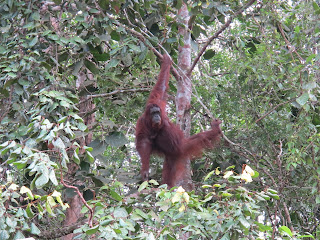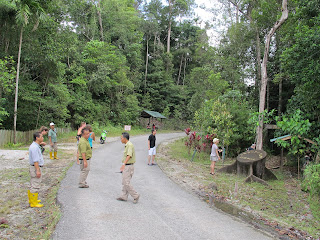In the humid afternoon sun at least 30 people trudged up the asphalt road, surrounded by rainforest on both sides, to get a glimpse of one our closest relatives: the orang-utan (Pongo pygmaeus). We didn't have to wait too long. Within minutes an adult female and youngster appeared on top of a roadside fence, and shortly after, crossed the pavement before ascending a utility cable. We scampered close, but stayed a bit back, as these red apes can be exceptionally surly. Alli and I raised our bionculars up and got a phenomenal look at an animal that is living on borrowed time. To twist the title of one of Funkadelic's rowdiest jams, and turn it into a pessimistic environmental critique: these mammals are standing on the verge of blinking out.
 |
| Top photo: Adult female Orangutan (Pongo pygmaeus) chilling on an electrical cable. Above: Stretching it out. The resemblance to people is incredible. *** All photos can be enlarged by clicking on them. *** |
We had reservations about coming here. To the Semenggoh Nature Reserve that is. Located outside Kuching, in Malaysian Borneo, the area is amidst the city's burgeoning urban sprawl of malls and food joints, reminescemt of Arizona. We spent about three weeks in the greater Kuching area. As soon as the mama and young-in were seen the cameras came out and the clicking started at a fierce clip, myself included. I'd never seen orangutans in their native habitat before, but instead of getting goosebumps I just felt cheap and gross. Us tourists seemed as much a spectacle as these apes. I felt cheap, cause hello, admission to the park is cheap: $3.30 U.S. per person. Seeing them in dense rainforest "in the wild" costs prohibitively more. The gross feeling comes from the realization that coming here is probably doing these apes more harm than good.
 |
| Top photo: Coralling the tourists before the big show. Not much helpful or interesting info was provided. Above: Onward march. |
The scenario goes like this: Borneo has been hacked down at an astronomical rate. The
percentage of vanished rainforest is so high it takes a little while to digest
the numbers. Three nations comprise Borneo: Indonesia (the massive state of
Kalimantan), Brunei (tiny and gushing with oil dollars) and Malaysia accounting
for two separate states: Sabah and Sarawak spread out from coast to coast in
the north. Alli and I spent all our time in Sarawak. To do the cultural
multiplicity and biodiversity of this island justice would take years. To keep
things simple, and because I’m not any type of authority on Borneo
deforestation, I’m mainly going to discuss Sarawak, based on our experiences,
what I’ve read and researched, and the people I’ve had the pleasure to chat
with.
 |
| Top photo: I love ridiculous green washing signs! Above: The first sight we had of the female carrying her kid on her back. |
Seventy (70) percent of Sarawak’s rainforest has been destroyed
in the last 20 years alone. Some sources say only three (3!) percent of the
state’s primary rainforest is left. Three percent? It’s pathetic. I think one
needs to read those numbers a few times to fully appreciate the wanton
decimation. In my lifetime Sarawak’s ground went from rainforest to
monoculture. Trees were chained sawed with delight, the earth got scorched to a
crisp and in its wake vast seas of oil palm plantations sprouted up. To put it
bluntly, Borneo will never be the same. Numerous people, and their indigenous
way of life and land, were bladed and displaced. Politicians, wealthy insiders
and government cronies got stupid rich, while already poor people got poorer.
It sounds so cliché, but that doesn’t make it any less sad. Aside from the
human attrition of the last decades, the orangutan, with countless other
rainforest species, has suffered the same fate.

 |
| Top photo: Looking out our plane's window at an endless oil palm plantation. Sarawak (and most of Borneo) used to be covered in forest, but now oil palm monoculture is king. This plantation was seen on our way to Gunung Mulu National Park in NW Sarawak, it's not near Semenggoh. Above: About to go up. |
The reason we felt cheap and gross is a little more
complicated. With this reserve being so close to Kuching, it’s a hefty draw to
any tourist who visits eastern Sarawak. Orangutan posters, images and tour ads
are dispersed throughout the city. At the entrance station to Kubah National
Park the only poster plastered on the wall was of two orangutans about to kiss.
It was from Malaysia’s Ministry of Tourism, with their boastful tagline
“Malaysia – Truly Asia,” the only text. How cute.
 |
| The youngster putting on a show with its plastic bottle while all of us snap away below. |
Now to see these creatures in their native habitat,
“in-the-wild,” so to speak, it ain’t cheap. It costs a lot and there’s no
guarantee you’ll even see them. I believe it’s easier to see them in Sabah and
Kalimantan, but don’t quote me, I’m just an out-of-work lowly blogger. Alli and
I decided it was too expensive to go spend a week or so trying to get a peek at
our red relatives. It’s not because we’re cheap, but once you start traveling,
you realize you can’t do everything.

What sucks is that the guided trips to see these wild orangs
are the people you should support with your tourist dollars. Local guides and
communities who are helping preserve the habitat and fight for conservation in
a state that badly needs it (with only 3% left you don’t have much to lose).
But alas, this one we would sit out. I told Alli I’d settle for Semenggoh. She
told me why we shouldn’t go. I processed it and had my qualms, but I wanted to
see it anyway to experience the hackneyed display. Very quickly I learned she
was spot on. The reasons follow.
When rainforest is getting ravaged orangutans are found.
These creatures don’t like to go to ground as they spend almost all their time
up top in the trees. The found orangs are gathered up and then sent off to a
reserve such as Semenggoh. Maybe some also get recovered from the black-market
wildlife trade. Semenggoh is only 653 hectares. Anyone remember how many acres
or square miles to a hectare? Me neither. Thanks again Internet. This reserve
constitutes 1,614 acres or 2.52 square miles. Small change. For all my desert
folks out there, in comparison the Tucson Mountain District of Saguaro National
Park (you know, the park whose main entrance is just past the Desert Museum) is
about 24,000 acres or 37.5 square miles. By no means is TMD considered a
‘sizeable’ national park. Semenggoh is not even twice as big as Tumamoc Hill in Tucson.
 |
| Get why is feels like a zoo? |
So this parcel of orangutan land is tiny. But it’s bubbling
over with animals. And that’s what tourists want to see. The argument is quite
simple. The logging industry and political muscle have an impeccable card to
play: why preserve all this natural habitat (the rainforest that is
disappearing) when you can have a bunch of orangutans in a minuscule reserve
that tourists flock to. Why conserve a patch of land the size of Grand Canyon
National Park when teeny
Chiricahua National Monument will
do? Its win-win-win, according to Michael Scott’s conflict resolution binder.
Orangutans can continue to live; tourists are placated and
satisfied; and logging and monoculture keep moving on unabated. By showing up
with our Ringgit to pay and my camera ready to go gonzo for orang, we are
partly complicit in the miserable slide of Borneo’s rainforest and orangutans
into the annals of history. Whoa, that was a loaded, dramatic sentence. What
I’m trying to get at here is that these orangutans are one baby step above a
zoo population. They’re not playing their ecological roles in the forest,
they’re playing their entertainment roles, just like in the kissing poster I
observed at Kubah.
 |
| I love this photo. These apes are beyond agile. |
The other aspect in this equation is that the rainforest
harbors a whole lotta more species of plants and animals. Orangutans just
happen to be the most charismatic, with faces, hands and limbs like us. That’s
also why Alli and I visited Borneo. The name alone conjures up naturalist
adventure and gets the brain buzzing with the awesome number of things one can
see here in the rainforests: hornbills, cobras and reed snakes, tarsiers, sun
bears, leafbirds, stick insects, flying frogs, minivets and tons more. Where do
they all go? A few of the more charming species might get placed into a
sanctuary, but the others disappear, die, maybe a few migrate on and find some
habitat elsewhere. Some species can make do in the plantation.
 |
| Concrete jungle. |
The future indeed looks grim for Borneo, its rainforest, indigenous
people, orangutans and all the other countless species. But pessimism is a dead
end street. Wide-eyed optimism with the determination to fight must continue.
Without trying everything would be screwed anyway. So my moldy field hat goes
off to everyone trying to protect what Borneo has left. I’m glad I saw the female
orangutan and her kid at Semenggoh. It makes you realize how little time this
species and its habitat have if the chain saws don’t cease. By the end of this
decade most of the indigenous people’s ancestral land could be gone, along with
any other tracts of remaining rainforest. Poof! Semenggoh could easily become
an outdoor zoo, no more need to label it a reserve. Tourists would still show
up and Sarawak Forestry could charge a lot more than $3.00 USD a head.
More photos of the whole experience can be found below:
 |
| Jeeeeez, look at those back muscles! |
 |
| People have short attention spans. Pretty soon, the crowd fizzled out. |























